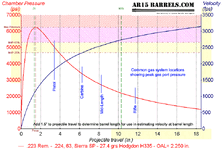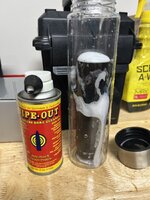So can someone explain to me how a suppressor is increasing the pressure to higher levels when the peak pressure is achieved long before the bullet is anywhere near the suppressor? By the time the bullet gets all the way down to the end of the barrel the pressure in the barrel is substantially lower than the 55k+ psi peak pressure so as a result any back pressure from the suppressor would be substantially lower.
My guess is one of two things happening, the first is that blow back gases are increasing the chamber fouling resulting in the case not gripping the walls as tight during firing. This could resulting in an increase in bolt thrust which would show up as ejector marks since the brass is pushed onto the bolt face with more force as it breaks free earlier in the pressure cycle.
The second is that the prolonged back pressure due to the can maintaining some of the pressure after the bullet has left the barrel could result in the brass being pushed back against the bolt face after it is no longer expanded to the point of pushing against the chamber walls.
Essentially in both cases it isn’t that the suppressor is causing higher chamber pressures and an unsafe load, it’s that it is causing false pressure signs in the brass after the bullet has left the barrel.
My guess is one of two things happening, the first is that blow back gases are increasing the chamber fouling resulting in the case not gripping the walls as tight during firing. This could resulting in an increase in bolt thrust which would show up as ejector marks since the brass is pushed onto the bolt face with more force as it breaks free earlier in the pressure cycle.
The second is that the prolonged back pressure due to the can maintaining some of the pressure after the bullet has left the barrel could result in the brass being pushed back against the bolt face after it is no longer expanded to the point of pushing against the chamber walls.
Essentially in both cases it isn’t that the suppressor is causing higher chamber pressures and an unsafe load, it’s that it is causing false pressure signs in the brass after the bullet has left the barrel.


